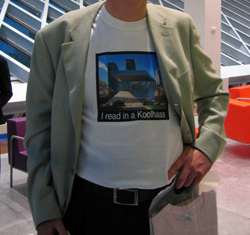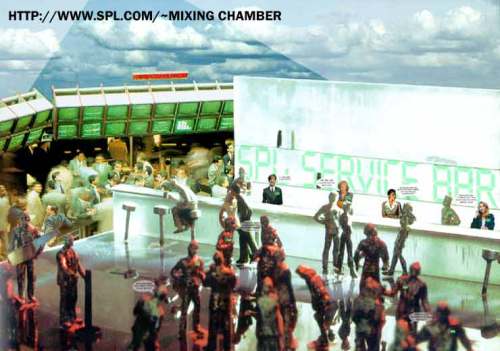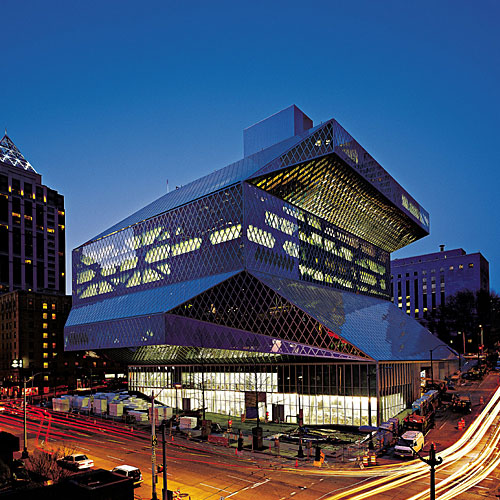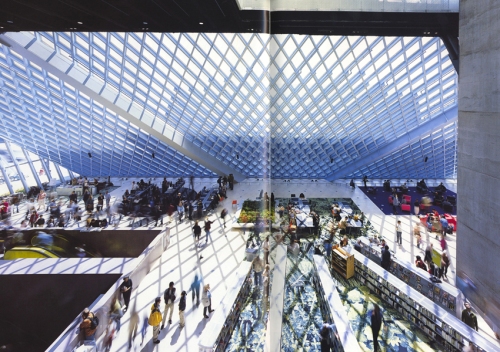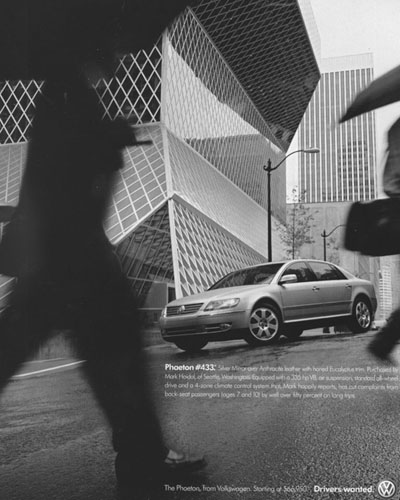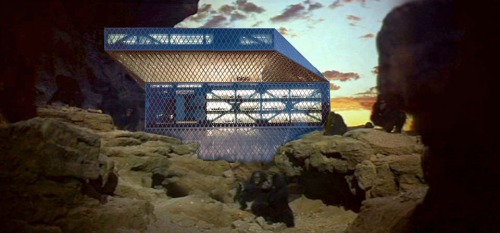Here the Seattle Central Library is represented on the t-shirts available for purchase by patrons at the library’s gift shop which reads “I read in a Koolhaas”. This representation is worn by people, as a memento of their trip to the library. Like the prominent t-shirt with designer-name logo, now patrons can also exhibit their taste in buildings on their body. Through this deliberate product of the marketing/branding exercise, the image of the building is suddenly transformed into an article of consumption and circulated around the globe, as if the architecture had suddenly lost its mass and volume, and could now be consumed in such an original medium as clothing. Rather than architecture hosting the body, it is the body that hosts architecture, creating an extraordinary inversion of the traditional roles. In some way, this can be considered as an peculiar embodiment of architecture.
Posts Tagged 'photograph'
t-shirt
Published March 11, 2008 Uncategorized Leave a CommentTags: distribution, exterior, general, perspective, photograph, print, SPL, t-shirt
collage: mixing chamber
Published March 10, 2008 Uncategorized Leave a CommentTags: architect, concept book, conceptual, general audience, human figure, interior, photograph, web
This collage depicts the mixing chamber on the 5th floor of the Seattle Central Library, on the top of the floating platform dedicated for meeting rooms. This sort of representations is usually devised not to transmit an actual impression of space, but an intention of experience and atmosphere in a certain space. In this case, we can observe how patrons and librarians interact in a constant flow of interdisciplinary information, creating a stimulating environment of exchange. Upon closer inspection, it is possible to read the dialogues between individuals, which create the basic structure and most important feature of this space, namely social interactions (which can seem odd, given that it is a library). Remarkably this impression is transmitted not only by the serious accumulation of several agents, but also by the creation of small disconnected narratives, which do not follow the traditional linear structure of several different pieces necessarily following one after another to constitute a whole, but the existence of all these parallel (and possibly interconnected) stories create and transmit the notion of diversity and fluidity intended for this space. Interesting analogies to other (familiar) spaces are also embedded in this collage, namely by the positioning of informational screens and bar stools, attempting to translate the innovative idea of a “mixing chamber” by approximation (or hybridization) of other existing spaces.
photo: personal snap shot
Published March 10, 2008 Uncategorized Leave a CommentTags: discussion, exterior, flickr, general audience, human figure, perspective, photograph, public, web
In this image, the Seattle Central Library is illustrated in a personal photo uploaded on the popular photo sharing website flickr by the user fromform taken during the opening of the library. We can observe the playful interaction between the two friends and the metallic mesh on the 5th avenue entrance of the library. Unlike most common photographic records of this building, here the focus is on the people in the photograph and not on the library, which is relegated to mere scenery. However, by engaging with the façade’s net, they offer a new reading of the building, namely by giving a proper sense of the scale of this massive grid pattern of the façade. In this user’s online photo, as well as those of most other users, the viewer is invited to observe a private moment . This level of personal exposure is now available to everyone, and the boundaries between privacy and publicity become ever more blurred, mostly produced by the new business plan of web2.0 sites where users generate the content. This picture which serves to this specific user as a memento of the time spent at the library with her friend thus becomes another way through which this piece of architecture is mediated and exposed to the larger public.
see fromform’s photographic set of Seattle’s Central Library here
photo: exterior at night
Published March 9, 2008 Uncategorized Leave a CommentTags: 4th avenue, distribution, exterior, general audience, perspective, photograph, print, professional audience, web
(from the corner of 4th avenue at night)
Here is another photo directed to the professional realm which depicts the building without humans despite being able to see inside it because of the relative exterior darkness. The library does appear “friendlier” at night as its functional nature, via its program platforms, is made visible. It “explains” itself, rather than appearing as an inexplicable monolith. In these photos, through which the building communicates itself to other architects and builders, it is most frequently shown in full, emphasizing its outline which OMA has deemed a “genetic” modification of a typical American high-rise, making the building “sensitive,” “contextual,” and “iconic.” (OMA Proposal, pg. 24)
flash / quicktime vr: virtual tour
Published March 9, 2008 Uncategorized Leave a CommentTags: 3-D, 5th avenue, architect, book spiral, distribution, exterior, general audience, human figure, interactive, interior, living room, photograph, plan, professional audience, reading room, Rex, section, tour, web

Click on the image to start the shockwave virtual tour conceived by OMA and Rex. To view this tour, you need Shockwave installed on your system and a 3D-capable video card. We recommend a card of 64 MB or more to view the movies in high resolution. A video card with less memory requires a bit more loading time and will result in lower resolution.
This representation can best be described as a virtual tour, which using as basis several photographs taken from the same point but towards different positions are combined together in a three dimensional space by the computer, allowing the viewer to look into all possible directions from a given point. This system attempts to recreate an immersive perception of interior and exterior spaces, enhanced by positional information supplied on the x,y coordinate by the plan and on the z coordinate by the cross section. Furthermore, the viewer has the possibility to move through space (from point to point), reflecting the spatial relationship between these points. Therefore, it is possible to meander through all the public spaces of the library, since the staff floor and the headquarters floor are not represented. Despite the wide coverage of this building by the popular and professional media, or perhaps because of it, photographs of the 2nd and 11th floor spaces are not widely available, and are normally physically not accessible to the public. Similar to Intel’s processors equipped with a Protected Mode, the operating system of this building, where staff meets and controls the library is protected from the users, providing a zone of privacy contrasting to the publicity of other media saturated spaces.
photo: interior “urban living room”
Published March 8, 2008 Uncategorized Leave a CommentTags: agent, Bordieu, distribution, el croquis, field, general audience, human figure, interior, perspective, photograph, print, publication
This photo appeared in the architectural journal, El Croquis as part of a mopnograph on Rem Koolhaas/OMA, where an extensive profile of this building is featured. It depicts the “urban living room” on SCL’s 3rd floor.
As you can see, the landscape orientation of the photo, spreading across two pages, focuses on a horizon where the glass skin meets the floor. Shot from a high angle (5th floor) and using an extremely wide-angle lens, as evidenced by the distortion in the foreground, this is an image of the building as landscape. People move through this landscape — their movement is evidenced also by distortion — but they are clearly not the subjects of this image. All of the dramatic diagonal lines lead the eye to a center where there are no people at all.
The dominant visual feature of the images is those diagonal lines, which cover almost the entire image and give the distinct impression of a net, as if a visual metaphor for a network, which is one of the dominant metaphors for society in the information age.
This image could also be said to express Bordieu’s explanation of “the true object of social science” which is not the individual, but the field. In this image, the individuals exist “as agents – not as biological individuals, actors, or subjects – who are socially constructed as active and acting in the field.” The field here being, graphically and dramatically, the library building itself.
There is further evidence of this conception of human individuals as agents in the field that is the building in the conceptual imagery and in the video-lecture by Joshua Prince-Ramus, the architect in charge of construction.
print advertisement (volkswagen)
Published March 6, 2008 Uncategorized Leave a CommentTags: distribution, exterior, general audience, human figure, perspective, photograph, print, volkswagen
This portrayal of the Seattle Central Library was circulated in the popular print media as an advertisement for a Volkswagen car. Several readings can be made from this image; perhaps one of the most fascinating would entail a discussion of the association of this building’s image to a product (in this case a car) as a means of connoting a certain lifestyle and experience. In this regard it is appropriate to consider that we are not only experiencing a shift from a print-based to a digital-based society, but also from a service economy to what has been coined an experience economy, where the particularity of the experience establishes the difference between otherwise similar products in highly saturated markets. This advertisement illustrates this idea quite cunningly, by minimizing the image of the car, but still framing it between the large human figure in the foreground and the building in the background. This layout leads the viewer’s eye to focus on the car and directly associate it with the original and rule-defiant design of the library, emphasized by the contrast created with the generic office building visible further in the distance. The defiance of preconceptions is extended by the inversion played out in this image, where the human figure appears to be in motion and the vehicle seems to be static.
collage: dawn’s monolith
Published March 6, 2008 Uncategorized Leave a CommentTags: collage, discussion, exterior, general audience, human figure, perspective, photograph, public, web
google earth
Published March 6, 2008 Uncategorized Leave a CommentTags: discussion, exterior, general audience, google earth, photograph, public, web
In this representation the Seattle Central Library (or its construction site) can be observed from a top viewpoint, achieved by aerial imagery composed almost flawlessly from different sources via the Google Earth software. Complementary, this tool also engages with several different databases and creates a representation of the world enhanced by information and (in some places) by 3-D buildings. As Google Earth liberates the public from its customary street view and empowers it to explore landscapes and urban settlements alike from uncustomary viewpoints, several issues arise. First and foremost, privacy and publicity becomes a concern. In this specific top view it is possible to observe the connection between different sources, which seem to create a space of warped dimension, a space where the shifting form of the Seattle Central Library seems to belong. Paradoxically, in that specific image the site is still under construction and the sinuous shaped building is missing, being only present in the modified image where its 3-D avatar has been created, in the company of the surrounding straight buildings which visually correct the originally blurred z dimension. Visually, Google Earth allows users to see and float through space revealing different viewpoints to familiar and unfamiliar scenes, but also through time in their asynchronous updated image database.
photo: exterior at twilight
Published March 3, 2008 photo , print Leave a CommentTags: 5th avenue, distribution, el croquis, exterior, general audience, perspective, photograph, print, professional audience, publication
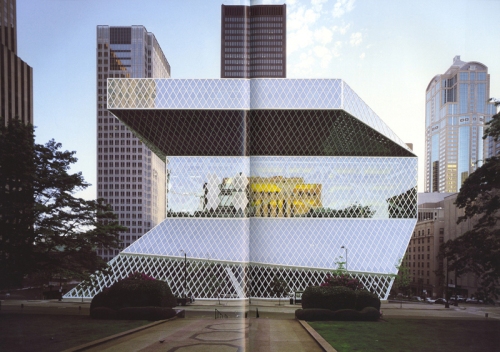
This photo appeared in the spanish architectural magazine, El Croquis as part of a monograph on Rem Koolhaas/OMA. This photo was taken from the small public space directly across 5th avenue.
This photo is particularly telling in that it presents the building as a rather whimsical character. Although it has a landscape orientation, the centrality of the building and the very-nearly-symmetrical formal garden in the foreground, lend an air of portraiture. The severe verticality of the buildings in the background stand in sharp contrast to the asymmetry of our daring hero in the foreground who literally shines in comparison. In our hero’s reflective surfaces the sky leads its mirror-life, and he literally reflects back, from the middle of his “face” his square (literally and figuratively) neighbor, demonstrating how much younger and savvier he is.
Note, there are no pesky human figures to draw attention aware from the protagonist in this image. What is more, there is no visual indication whatsoever of an entrance or even the possibility of entrance, as if entrance is not necessary, as if the building’s presence suffices to impart intelligence like a cubist vision of Kubrick’s monolith.
